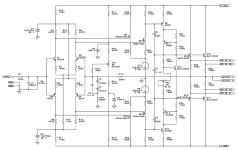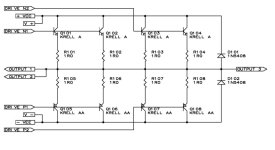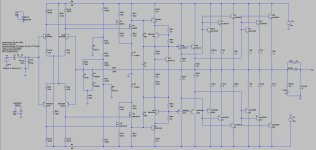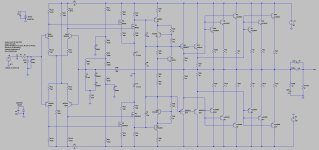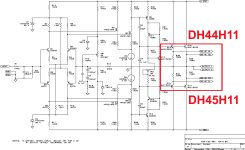I have ambitions to build a variation of the KSA-100 MKII clone. I have a ton of parts and things to make it happen yet I am lacking a few hundred bucks worth of items that are on order or will be ordered soon. I guess, hell or high water I am committed to it. I want to make the best of it. I have received criticism for this decision. I may have to live with it and let it take its course as all things do. In an effort to move forward I would more than nothing desire a relatively somewhat functional LT SPICE model to go along with said project.
Attachments
It is funny to simulate as it works so devastatingly bad. OMG it is terrible. Kinda makes me laugh and cry.
I require MOSFET models and help to implement them. Getting models that are relevant may be an issue. IDK.
If you people could look it over and give me some pointers, I will run with it and make the best of it.
I'm kind of lost at this point. I've been stuck here for a few days now.
I require MOSFET models and help to implement them. Getting models that are relevant may be an issue. IDK.
If you people could look it over and give me some pointers, I will run with it and make the best of it.
I'm kind of lost at this point. I've been stuck here for a few days now.
The values of everything are kind of random so if you see strange resistors or transistors where they don't belong, you understand it is all a part of my experimentation.
Fantastic. 🙏I think that you connected Q13 and Q15 bases to the wrong point. That would make it act oddly.
Just had a quick play. Bias adjustment is very model dependent, stability seems on the edge...
You need defined models for the NMOS, not just the defaults. 52pF caps cause instability (now 100pF). Bias setting resistor altered. CCS at 3ma, rails at -/+56. Zeners now connected. Offset range with R values poor... altered.
Bias set to 370ma per pair, no idea what the recommended value is. Sim parameters now set the old fashioned way 😉
You will have to swap your own models into the sim.


You need defined models for the NMOS, not just the defaults. 52pF caps cause instability (now 100pF). Bias setting resistor altered. CCS at 3ma, rails at -/+56. Zeners now connected. Offset range with R values poor... altered.
Bias set to 370ma per pair, no idea what the recommended value is. Sim parameters now set the old fashioned way 😉
You will have to swap your own models into the sim.
Attachments
If you decide to build this, fuse the lines between the storage capacitors and the amp. My KSA100II blew up twice. Once just the power transistors going short circuit. And the other time it also took out the drivers and the 75 ohm driver load resistors to the extent the resistors burned clean through the board in a cloud of smoke. Hell of a mess. Carbonised holes in the board. The saving grace is that the large protection relays in series with the loudspeaker outputs worked perfectly, and in spite of the catastrophic failure did not even produce a click from the speakers.
I suspect that when the amp powers up, it can go through a burst of oscillation at a high frequency. And that can easily destroy at least the power transistors.
The problem with the original dual mono design is that there are two 2kVA transformers, big rectifiers, and monster smoothing capacitors - so there is massive stored energy from the capacitors, fed endlessly from the transformers, to feed the fire.
Fuses between the reservoir caps and the amp might not save the silicon, but it will sure prevent clouds of smoke and a destroyed circuit board.
I suspect that when the amp powers up, it can go through a burst of oscillation at a high frequency. And that can easily destroy at least the power transistors.
The problem with the original dual mono design is that there are two 2kVA transformers, big rectifiers, and monster smoothing capacitors - so there is massive stored energy from the capacitors, fed endlessly from the transformers, to feed the fire.
Fuses between the reservoir caps and the amp might not save the silicon, but it will sure prevent clouds of smoke and a destroyed circuit board.
I see what you are saying. A basic internal deployment of old-school-fuses on the rails. I may do that in a fuse holder on top of the PSU buss bar.If you decide to build this
Sound advice. ✅
That is some kind of tune-up job there. Wow. I thank you for that and I'll make a go of it. Should put me on the good foot.Just had a quick play.
I was forced to do some digging. I have had some good LT Spice libraries in the past and I dug one such thing up on an old hard drive. Then I scanned diyaudio and found a link to a massive FET library. I've ordered transistors for this project I currently do not have stock of. When they arrive, I can measure them and add them to the simulation to dial it in.
I have a working base model now and lots of tinkering to do. So thank you.
I had a dream last night that involved building this thing. Weird.
I have a working base model now and lots of tinkering to do. So thank you.
I had a dream last night that involved building this thing. Weird.
I have D44H11 and D45H11 comp pairs. They measure almost exactly 205 and 210 HFE. Why not use them (a)?
I have MJE15030 and I have MJE15031 comp pairs. The 30s measure 100-ish HFE and the 31s measure 300-ish HFE.
I bought about 500 each of the MJEs(30-31) over the years trying to get them to match. NEVER succeeded.
The D45s and D44s are tight on the bench. I have never listened to them before, though I have had them in my stash for 10 years+
I deployed them in service work with above-par results but I never LISTENED to them. My 'customers' hear them.
DO YOU have experience with D45H11 and D44H11 in your audio projects?(b) DO YOU like them/sound?(c)
Alternate question(d): SHOULD I buy a boatload of MJE15032s and MJE15033s because I may get a better Beta Match? It'll set me back $500CAD. I can recoup the money in service work but am I likely to score HFE matches? (e)
Bob Cordell may have told me that I can drive a million MJ21193/94s with a single pair of MJE15030/31s.
Bob Cordell may have told me that I can parallel my DH45/44s or MJEs with little to no sacrifice.
Bob Cordell may have released a new addition of his book a few years ago and we should all buy a copy(I did).
This simulation on my computer is starting to behave well. I am happy with that. I have the boards ready to stuff and I am getting impatient, my soldering iron yearns for fresh gold flashed PCBs. Do you have staring contests with your soldering iron? Apparently, I do.
I have MJE15030 and I have MJE15031 comp pairs. The 30s measure 100-ish HFE and the 31s measure 300-ish HFE.
I bought about 500 each of the MJEs(30-31) over the years trying to get them to match. NEVER succeeded.
The D45s and D44s are tight on the bench. I have never listened to them before, though I have had them in my stash for 10 years+
I deployed them in service work with above-par results but I never LISTENED to them. My 'customers' hear them.
DO YOU have experience with D45H11 and D44H11 in your audio projects?(b) DO YOU like them/sound?(c)
Alternate question(d): SHOULD I buy a boatload of MJE15032s and MJE15033s because I may get a better Beta Match? It'll set me back $500CAD. I can recoup the money in service work but am I likely to score HFE matches? (e)
Bob Cordell may have told me that I can drive a million MJ21193/94s with a single pair of MJE15030/31s.
Bob Cordell may have told me that I can parallel my DH45/44s or MJEs with little to no sacrifice.
Bob Cordell may have released a new addition of his book a few years ago and we should all buy a copy(I did).
This simulation on my computer is starting to behave well. I am happy with that. I have the boards ready to stuff and I am getting impatient, my soldering iron yearns for fresh gold flashed PCBs. Do you have staring contests with your soldering iron? Apparently, I do.
Attachments
Last edited:
I was seriously considering paralleling the BASES, EMITTERS and COLLECTORS. Sure they will be matched 99.9%.
As previously stated, be careful about transient stability during power up of Krell power amps of this generation. As stated, my KSA100II blew twice during power up. And immediate after I bought it (second hand) I checked the RC zobel across the speaker terminals - it was in shrink fit - and one of them the resistor has cooked and the capacitor had voided its foils - suggesting it had cooked during a rail to rail burst of oscillation of the power amp.
And in a dealership in Cambridge UK, I looked at a KSA50 that had evidence of smoke from that dying around the ventilation grills in the top. It had been repaired, but the KSA50 and 100 shared a similar class A design, suggesting that blowing up was a common feature.
Perhaps sequentially powering up might be something worth considering. So the amp with drivers first, and then a second or two later, the power transistors.
And in a dealership in Cambridge UK, I looked at a KSA50 that had evidence of smoke from that dying around the ventilation grills in the top. It had been repaired, but the KSA50 and 100 shared a similar class A design, suggesting that blowing up was a common feature.
Perhaps sequentially powering up might be something worth considering. So the amp with drivers first, and then a second or two later, the power transistors.
- Home
- Amplifiers
- Solid State
- Krell KSA 100mkII LT SPICE
